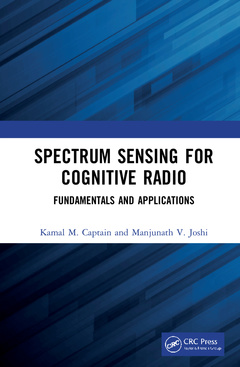Description
Spectrum Sensing for Cognitive Radio
Fundamentals and Applications
Authors: Captain Kamal M., Joshi Manjunath V.
Language: English
Subjects for Spectrum Sensing for Cognitive Radio:
Keywords
Spectrum Sensing; Wideband Spectrum Sensing; Cognitive Radio; CSS; Wideband Spectrum; Diversity Branches; Noise Uncertainty; Average SNR; Spectrum Opportunities; Hard Combining; Proposed Detection Algorithms; CDF; Soft Combining; Secondary Users; Primary User Signal; Wideband Sensing; Antenna Diversity; Wide Sense Stationary; Fading Channel; AWGN Channel; Compressive Sensing; Non-central Chi Square Distribution; CR User; Spectrum Holes; Low SNR
123.78 €
In Print (Delivery period: 14 days).
Add to cart· 15.6x23.4 cm · Hardback
Description
/li>Contents
/li>Readership
/li>Biography
/li>
This comprehensive reference text discusses concepts of cognitive radio and the advances in the field of spectrum sensing.
This text discusses the concept of cognitive radio for next generation wireless communication and a very critical aspect of cognitive radio ? that is, spectrum sensing ? in detail. It covers important topics including narrowband spectrum sensing, wideband spectrum sensing, cooperative spectrum sensing, system and channel models, detection algorithms, approximation of decision statistics, and theoretical analysis of detection algorithms in detail. Separate chapters are dedicated to discussing the analysis and use of detection algorithms for narrowband spectrum sensing, wideband spectrum sensing, and cooperative wideband spectrum sensing.
Aimed at graduate students and academic researchers in the fields of electrical engineering and electronics and communication engineering, this text:
- Discusses concepts of cognitive radio and research in spectrum sensing.
- Presents mathematical analysis of algorithms considering practical environment.
- Explains novel wideband spectrum sensing algorithms with detailed analysis.
- Provides mathematical derivations to help readers.
- Discusses basic spectrum sensing algorithms, from narrowband spectrum sensing to the more advanced wideband spectrum sensing.
1. Fundamentals of Probability Theory. 2. Introduction. 3. Literature Review. 4. Energy Detection based Spectrum Sensing Over Generalized Fading Model. 5. Generalized Energy Detector in the Presence of Noise Uncertainty
and Fading. 6. Diversity for Wideband Spectrum Sensing Under Fading. 7. Cooperative Wideband Spectrum Sensing. 8. Conclusions and Future Research Directions. 9. Appendix A Appendix for Chapter 1. 10. Appendix B Appendix for Chapter 4. 11. Appendix C Appendix for Chapter 5. 12. Appendix D Appendix for Chapter 6. 13. Appendix E Some Special Functions. 14. References.
KAMAL M. CAPTAIN:
Dr. Kamal M. Captain received his Ph.D. in the area of Spectrum Sensing for Cognitive
Radio from Dhirubhai Ambani Institute of Information and Communication
Technology (DAIICT), Gandhinagar, India. Before this, he completed his M.Tech
in Communication Systems from Sardar Vallabhbhai National Institute of Technology
(SVNIT) and B.E degree in Electronics and Communication Engineering from
Veer Narmad South Gujarat University (VNSGU), Surat, Gujarat, India. He is currently
serving as an assistant professor at Sardar Vallabhbhai National Institute of
Technology (SVNIT), Surat, Gujarat, India. Prior to joining SVNIT, he served as a
senior engineer (signal processing) at eInfochips, Ahmedabad, India. He has been
involved in active research in the areas of cognitive radio, wireless communication,
signal processing, and machine learning and has several journals and international
conference papers, including IEEE Transactions. He has also served as a reviewer
for IEEE Transactions, letters, and top tier conferences.
MANJUNATH V. JOSHI:
Prof. Manjunath V. Joshi received the B.E. degree from the University of Mysore,
Mysore, India, and the M.Tech. and Ph.D. degrees from the Indian Institute of Technology
Bombay (IIT Bombay), Mumbai, India. He is currently serving as a Professor
and and Dean Research and Development with the Dhirubhai Ambani Institute
of Information and Communication Technology, Gandhinagar, India. He has been
involved in active research in the areas of Signal and Image Processing, Cognitive
Radio, Computer Vision, and Machine Learning and has several publications in quality
journals and conferences. He has co-authored four books entitled Motion-Free
Super Resolution (Springer, New York-2005), Digital Heritage Reconstruction using
Super-resolution and Inpainting (Morgan and Claypool-2016), Regularization in Hyperspectral
Unmixing (SPIE Press-2016), and the book e




